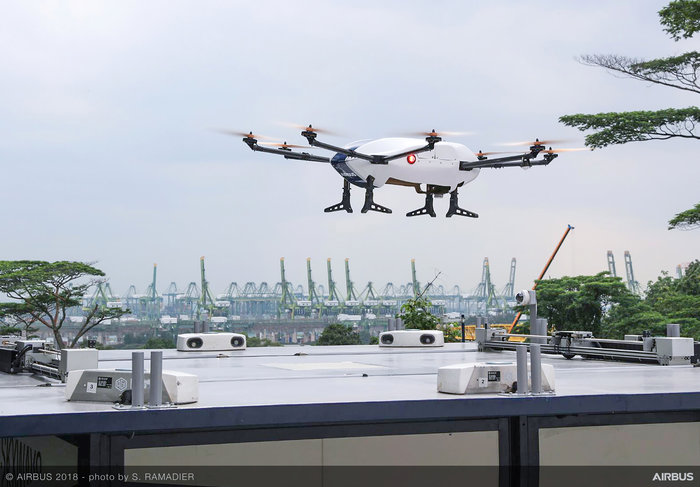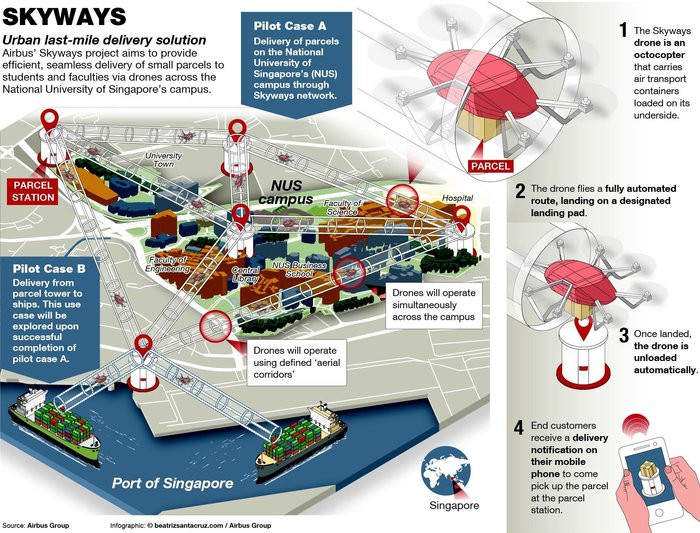 Leo Jeoh, Skyways project lead at Airbus, talks exclusively to Postal and Parcel Technology International about how the company is developing drone technology and revolutionizing the parcel delivery industry
Leo Jeoh, Skyways project lead at Airbus, talks exclusively to Postal and Parcel Technology International about how the company is developing drone technology and revolutionizing the parcel delivery industry
When and why was Skyways launched and what do you hope to achieve?
The Skyways project began in February 2016 when we signed a collaboration agreement with the Civil Aviation Authority of Singapore to look at the regulations and requirements for an unmanned air system (UAS) operating in an urban environment. We wanted to develop the technology, demonstrate then operate it, to determine whether it has certain commercial viability and to gauge public acceptance of the technology.
Was the project linked with the postal industry to begin with or was that how it progressed?
The project progressed to include the postal industry. Project Skyways is actually just one part of Airbus’s full-blown ambitions for urban air mobility. Other projects include City Airbus – an electric vertical take-off and landing vehicle for up to four passengers – and Vahana, a similar mode of transport for individual travelers or cargo transport. All of these projects involve flying vehicles as an alternative transportation means in the city. We had to start somewhere, but instead of flying people we looked at flying cargo. Postal logistics was one of the use cases we could explore and we found a suitable partner in Singapore – we signed a deal with SingPost in 2017, and decided to run this as our first use case, combining all the lessons we’ve learnt from the start of the project in terms of regulations and technology.
What other use cases are there?
We have been studying using the UAS to deliver other types of goods. The studies are still ongoing but we’re looking at ‘shore to ship’ for the maritime industry as well as overland deliveries that have more urgency, such as medical goods.
Why work collaboratively with SingPost instead of passing the technology over for them to test?
The use of drones in an urban city is tricky and we need to utilize experience in aeronautical products and certification to be able to ensure we have something that flies safely and does not put the public at risk. Our drone is very different from a consumer electronic product, such as the drones used for aerial photography. We are exposing the public to a higher level of risk – aviation safety risk – and so until the technology and requirements are mature, we wanted to develop the product safely so that it can fly in the city environment. Down the line, the drone could be handed over to a logistics company, but the technology and safety aspects are not ready for that yet.
How does the technology work?
One of the things we wanted to maximize was the autonomy of the system – it is fully automated. The delivery person puts a parcel into the UAS station, which is then automatically transferred by a robotic arm at the station into the drone. The drone then flies autonomously to the delivery address, lands automatically at the delivery station and the customer gets a notification that their parcel is ready to collect. There is no pilot involved in the navigation or flying, although until the technology is fully matured and we’re all comfortable with it, we do have some operators that are monitoring the systems so they can take any emergency action in case there are things that we have not foreseen.
In the future, I imagine the delivery stations would be invested in and installed by the commercial postal operator and it’s likely that they would be communal. SingPost already operates in this way in some sense – they already have their POPStations and we are working with them to apply our technology and evolve those stations so they can incorporate a UAS.
What have been the main challenges so far?
The key here is aviation safety. To fly a consumer electronic drone is easy, but to fly it commercially at the expected level of safety for the aviation industry, it needs to be designed specifically for that. The challenge has been to ensure all the components that we’ve developed meet the safety standards. We’ve had to trade-off redundancies in equipment and weight – we have redundant systems because of the safety level expected, but the heavier the drone gets, the less payload you can fly. So it has been tricky balancing the endurance and payload with the safety margins expected of an urban UAS. Generally, for the drone to have the necessary level of safety requires aviation-grade equipment in terms of navigation and electrical technology such as batteries.
What other safety considerations are there?
There are two concerns. Firstly, the logistics front-end security. This is led by SingPost, which is using its existing security considerations for the receipt of and delivery of the parcel. The second regards the flying of the drone. We have had to make sure it cannot be commandeered and become a public nuisance by being hacked in to. We’ve done a lot of research in terms of securing things like the communication channels and designing them to minimize the cyber security threat.
What are the next steps in the project?
We demonstrated the flying of the drone and the parcel stations at Singapore Airshow in February, so the technology is in the final stages of testing for us to start the first use case at the National University of Singapore. Our plan is to launch that service in the first half of 2018, to start collecting data and understanding issues relating to public acceptance and the commercial viability of the drone system in postal and parcel delivery. We’re still trying to decide how long we want to run this project – obviously it will be a couple of months on the campus but if everyone likes it and subscribes to it, we’ll run it for longer. By the end of this year, in discussion with SingPost, we hope to have a first sense of the viability of parcel delivery with drones.
What has the feedback been like so far?
The feedback has been great, and not just from the postal industry. We’ve had people from hospitals and other services coming to talk to us about how they can use the technology. I think what they see in this technology and the Skyways Project is that we’ve taken into account the safety and continued airworthiness aspects of the UAS, and of course Airbus is continuing to invest and improve this technology.
Do you envisage drone technology being widely adopted by the postal industry in the future?
I think it has quite a lot of advantages that the postal industry can make use of, in particular to SingPost – they have been looking at the ways in which they can reduce the manpower requirements for deliveries. Drone technology provides a level of autonomy that will be a great tool for the postal industry. The key is to make sure the cost and commercial viability of the technology does not overburden the postal industry, and that is something which remains to be studied, which is why we’re doing Project Skyways. We need to have the technology to demonstrate the delivery aspect first, and then we can investigate the commercial cost and viability. It’s a chicken and egg issue – a lot of people dream about this technology, but until you really have a physical implementation in a live environment, it is very difficult to substantiate any of these ideas.
By Hazel King
March 13, 2018
Read more about Project Skyways in the March issue of Postal and Parcel Technology International.



